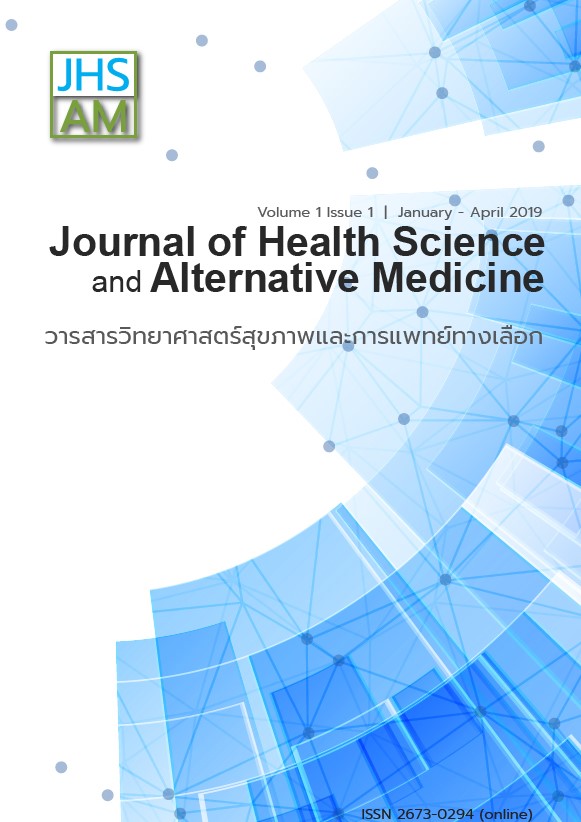Quality Evaluation and Pectolinarigenin Contents Analysis of Harak Remedy in Thailand
Main Article Content
Abstract
Introduction: Harak remedy is a Thai traditional medicine for anti-pyretic treatment. Some researchers reported that crude drugs and capsules of Harak remedy, which were distributed throughout Thailand, have been adulterated with the upper ground parts. Moreover, there is no recent report of quality control of the Harak products after marketed. Objective: Thus, aim of our research was to investigate the quality of marketed Harak capsules following requirements of Thai Herbal Pharmacopoeia (THP). Methods: The hierarchical cluster analysis (HCA) and principal component analysis (PCA) reported the similarity of samples to authentic Harak. The 18 samples were purchased from 6 regions of Thailand, 3 samples in each region (HR01-HR18). The authentic plants were collected from Surin province and provided as capsule drug (HR19). In addition, the powder of authentic remedy was extracted by aqueous and ethanol then the chemical constituents were analyzed by GC-MS. Results: As the result of standard specifications, 15 samples were standard medicines (83.33%) while 3 samples had high levels of total aerobic bacteria, total yeast, and molds. The chemical fingerprint and quantification of pectolinarigenin of 19 samples were investigated by TLC and RP-HPLC. The pectolinarigenin content of HR19 was 25.3±0.31 mg/g drug powder and the most correlated with were 3 samples as HR08, HR10, and HR16. Conclusion: According to HCA and PCA, most of the samples showed similar data patterns except HR17. The result provides essential information for identification of the Harak remedy for the purpose of quality control.
Article Details
JHSAM publishes all articles in full open access, meaning unlimited use and reuse of articles with appropriate credit to the authors.
All our articles are published under a Creative Commons "CC-BY-NC-ND 4.0". License which permits use, distribution and reproduction in any medium,
provided that the original work is properly cited and is used for noncommercial purposes.
References
[2] Jongchanapong A, Singharachai C, Palanuvej C, et al. Antipyretic and antinociceptive effects of Ben-Cha-lo-Ka-Wi-Chian remedy. J Health Res 2010; 24(1): 15-22.
[3] Juckmeta T, Itharat A. Anti-inflammatory and antioxidant activities of Thai traditional remedy called “Ya-Harak”. J Health Res 2012; 26(4): 205-210.
[4] Singharachai C, Palanuvej C, Kiyohara H, et al. Pharmacognostic specification of five root species in Thai traditional medicine remedy: BenCha-Lo-Ka-Wi-Chian. Phcog J. 2011; 3(21): 1-11
[5] Nutmakul T, Saralamp P, Prathanturarug S. An effective method for the identification of stem adulteration in BENCHA-LOGA-WICHIAN, a Thai traditional preparation. J Health Res 2013; 27(5).
[6] Jain R, Rawat S, Jain SC. Phytochemicals and antioxidant evaluation of Ficus racemosa root bark. Journal of Pharmacy Research 2013; 6: 615-619.
[7] Joseph B, Raj SJ. Phytopharmacological properties of Ficus racemosa L. An overview. Int J Pharm Sci Rev Res 2010; 3(2): 134-138.
[8] Luecha P. Chemical Constituents from Roots of Capparis micracantha DC. Khon Kaen University 2013.
[9] Somwong P, Moriyasu M, Suttisri R. Chemical constituents from the roots of Clerodendrum indicum and Clerodendrum villosum. Biochemical Systematics and Ecology 2015; 63: 153-156.
[10] Saiin C, Markmee S. Isolation of anti-malarial active compound from Yanang (Tiliacora triandra Diels). Kasetsart J (Nat Sci) 2003; 37 :47-51.
[11] Tuntiwachwuttikul P, Phansa P, Pootaeng-On Y, et al. Chemical constituents of the roots of Piper sarmentosum. Chem Pharm Bull 2006; 54, 149–151.
[12] Khuong-Huu Q, Chiaroni A, Riche C, et al. New rearranged Limonoids from Harrisonia perforata. Journal of Natural Products 2000; 63: 1015–1018.
[13] Khuong-Huu Q, Chiaroni A, Riche C, et al. New rearranged limonoids from Harrisonia perforata. Journal of Natural Products 2001; 64: 634-637.
[14] Choodej S, Sommit D, Pudhom K. Rearranged limonoids and chromones from Harrisonia perforata and their anti-inflammatory activity. Bioorganic & medicinal chemistry letters 2013; 23: 3896-3900.
[15] Juckmeta T, Thongdeeying P, Itharat A. Inhibitory Effect on ?-Hexosaminidase Release from RBL-2H3 Cells of Extracts and Some Pure Constituents of Benchalokawichian, a Thai Herbal Remedy, Used for Allergic Disorders. Evidence-Based Complementary and Alternative Medicine 2014.
[16] Hase CC, Le Dain AC, Martinac B. Purification and functional reconstitution of the recombinant large mechanosensitive ion channel (MscL) of Escherichia coli. J. Biol. Chem 1995; 270: 18329-18334.
[17] Yoo KM, Lee CH, Lee H, et al. Relative antioxidant and cytoprotective activities of common herbs. Food Chemistry 2008; 106: 929-936.
[18] Nugroho AE, Lindawati NY, Herlyanti K, et al. Anti-diabetic effect of a combination of andrographolide-enriched extract of Andrographis paniculata (Burm f.) Nees and asiaticoside-enriched extract of Centella asiatica L. in high fructose-fat fed rats. Indian Journal of Experimental Biology 2013; 51(12):1101-1108.
[19] Pal S, Choedhury A, Adityachaudhury N. Isolation of rice weevil feeding inhibitory uncinatone and pectolinarigenin from Cleodendrom siphonenthus. Journal of Agricultural and Food Chemistry 1989; 37: 234-236.
[20] Sakpakdeejaroen I, Juckmeta T, Itharat A. Development and validation of RP-HPLC method to determine anti-Allergic compound in Thai Traditional remedy called benjalokawichien. J Med Assoc Thai. 2014; 97 (Suppl. 8): S76-S80.
[21] Soonthornchareonnon N, Ruangwises N. Quality of Thai medicine: from researches to sustainable development. Bangkok: Concept Medicus; 2008: 519-10.
[22] Thai Herbal Pharmacopoeia. (1998). Thai Herbal Pharmacopoeia; Khamin Chan. Thai Pharmacopoeia Section, Bureau of Drug and Narcotic, Department of Medical Sciences, Prachachon Co Ltd., Ministry of Public Health, Bangkok, Thailand.
[23] Thai Herbal Pharmacopoeia. (2009). Thai Herbal Pharmacopoeia; Microbial Limit Test. Thai Pharmacopoeia Section, Bureau of Drug and Narcotic, Department of Medical Sciences, Prachachon Co Ltd., Ministry of Public Health, Bangkok, Thailand.
[24] Deng M, Hu B, Xu L, et al. OsCYCP1;1, a PHO80 homologous protein, negatively regulates phosphate starvation signaling in the roots of rice (Oryza sativa L.). Plant Mol Biol 2014; 86(6): 655-69.
[25] Singharachai C, Palanuvej C, Kiyohara H,et al. Pharmacognostic specification of five root species in Thai Traditional medicine remedy: Ben-Cha-Lo-Ka-Wi-Chian. Pharmacognosy Journal 2011; 3(21).

